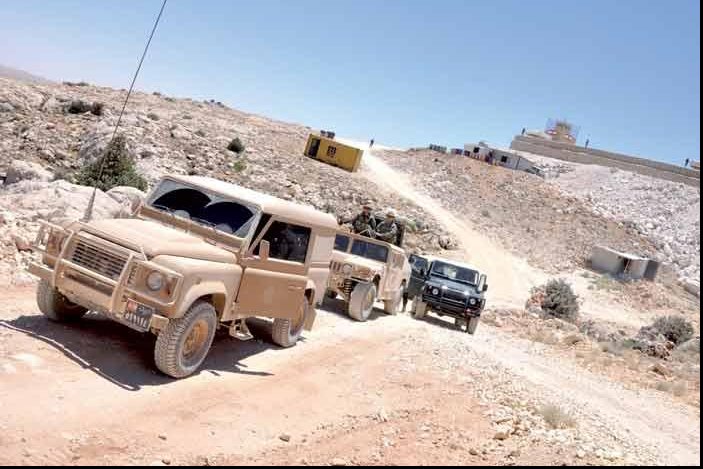Lebanese Army troops en route to the newly constructed Nimrod military base near Tufayl on Lebanon’s eastern border with Syria on July 14. Photo by Nicholas Blanford/The Arab Weekly
BEIRUT, Lebanon, July 31 (UPI) -- A long-awaited assault against extremist militants holed up in mountains along Lebanon's northeastern border with Syria is under way with Hezbollah spearheading the attack and swiftly seizing territory.
The offensive began July 21 as Hezbollah units moved north from their hilltop posts southeast of the town of Arsal into terrain controlled by Jabhat Fateh al-Sham, formerly known as al-Nusra Front. In just a few days, Hezbollah had seized most of the ground held by JFS and was poised to turn its attention to the Islamic State, which dominates the ground northeast of Arsal.
The Lebanese Army, which has a strong defensive perimeter around Arsal and a line of fortified observation towers along the western flank of the battleground, used artillery fire against groups of militants who tried to infiltrate the town during the fighting.
As this battle is fought in the rugged mountains of northeast Lebanon, 20 miles to the south, the Lebanese state is establishing a renewed presence along part of the traditionally neglected eastern frontier with Syria. The Lebanese Army's Fourth Land Border Regiment is building a line of fortified observation posts that gives sweeping views over the mountainous terrain and a large expanse of Syria near the isolated Lebanese village of Tufail.
The project of establishing land border regiments arose in 2011 when Syria was descending into civil war. The idea was to strengthen Lebanon's ability to secure its porous and largely unmarked border with Syria.
With the assistance of the United Kingdom, the first Land Border Regiment deployed in early 2013 along the northern border. Since then, two other regiments have been established and arrayed along the eastern border as far south as the slopes of Mount Hermon. The Fourth Land Border Regiment plugs a sensitive gap from just south of Arsal to the town of Masnaa on the Beirut-Damascus highway. Hezbollah has a presence along this stretch of the border. There are also three camps manned by a pro-Damascus Palestinian faction.
In early 2014, Hezbollah began building a series of compounds on mountain tops in this area to defend villages in the Bekaa Valley from militants infiltrating from Syria. At the time, Syria-based militants frequently fired rockets into the Bekaa. In September 2014, an al-Nusra Front militant set off a bomb in a suicide attack at a Hezbollah checkpoint near Khreibe village, wounding three Hezbollah fighters. The following month, al-Nusra fighters briefly overran a Hezbollah compound near the village of Brital, killing at least four fighters.
Since then, the security situation in the area has calmed down as the fighting in Syria shifted further from the border with Lebanon.
The calm in the area allowed for the Lebanese Army's newly formed Fourth Land Border Regiment to deploy into the Tufail area, replacing the Hezbollah fighters who abandoned their positions. It was a typically Lebanese display of pragmatism: Hezbollah freed up its fighters from watching a now-quiet stretch of the border for duties elsewhere and the Lebanese state stamped its authority on the remote location for the first time in decades.
The army moved swiftly to build imposing fortified compounds of 18-foot-high, rock-filled Hesco blast barriers that dominate the ground to the north, east and south in the Tufail Peninsula, a finger-like extension of Lebanese territory poking into Syria.
From the armor-plated watch tower, embellished with the Lebanese flag on all four sides and named after the remains of a small Roman temple nearby, soldiers enjoy extensive views east and south into Syria. They say they are confident that they can observe and intercept any attempts to penetrate this section of the border.
The recently abandoned Hezbollah outposts consisting of earth-filled oil drums and porta-cabins look frail alongside the army's new structures. Hezbollah is still in the area but on the Syrian side of the border where they share some positions with the Syrian Army.
At an altitude of 7,500 feet, the terrain in the barren mountains is harsh. New tracks slash through the limestone landscape and thick white dust billows from beneath the wheels of army vehicles as they grind up the hills. In winter, the mountains are blanketed with deep snow, posing another logistical difficulty for troops manning the lofty outposts.
The fighting further north along the border near Arsal has preceded at a speedy pace. It is unclear how long IS will be able to hold on when Hezbollah has finished with JFS and turns its attention to the extremists but the outcome will almost certainly spell defeat for the militants at which point Hezbollah is expected to leave the Lebanese side of the border and deploy elsewhere.
That would allow the Fourth Land Border Regiment to complete its deployment by moving into the area south of Arsal and build new outposts adjacent to those manned by the Second Land Border Regiment. Once that deployment is complete, the Lebanese state will have a full presence along the entirety of Lebanon's border with Syria for the first time since independence in 1943.
The next step, it is hoped, is to establish Fifth and Sixth Land Border Regiments, which would eventually deploy along Lebanon's southern border with Israel.
This article originally appeared at The Arab Weekly.















